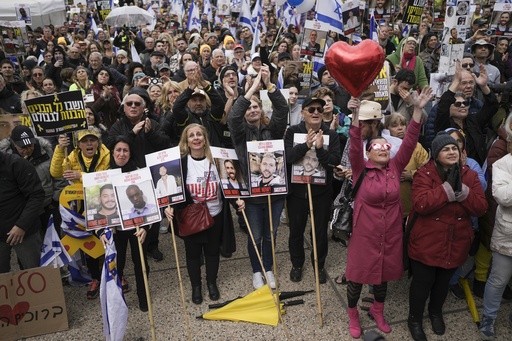
TEL AVIV, Israel — On Saturday, Hamas released six remaining hostages as part of the initial phase of a ceasefire agreement with Israel, just a week before the ceasefire is set to expire. This release has sparked increasing uncertainty regarding the next steps in the fragile deal. Among the six individuals released are three Israeli men who were abducted during the Nova music festival, alongside another individual seized while visiting family in southern Israel during the October 7, 2023, incursion by militants. Additionally, two long-held hostages were freed; each had been held in Gaza for nearly a decade after voluntarily entering the territory.
The transfer of five of the hostages occurred during orchestrated events that have drawn criticism from both the International Red Cross and various Israeli officials, decrying them as exploitative and inhumane. During these events, the released hostages, including Omer Wenkert, Omer Shem Tov, and Eliya Cohen, were displayed alongside armed Hamas fighters, with some engaging in seemingly celebratory gestures towards their captors. Their families, witnessing the release from Israel, expressed their joy and relief, chanting and embracing them upon their return. Shem Tov shared emotional moments with his parents, highlighting the overwhelming anticipation of their reunion.
Earlier on Saturday, two additional hostages — Tal Shoham, aged 40, and Avera Mengistu, aged 38 — were released and transported to medical facilities upon their arrival in Israel. Mengistu’s family has reported his ongoing struggles with mental health following his capture in Gaza in 2014. The final hostage, Hisham Al-Sayed, aged 36, was also released; he had entered Gaza in 2015 and has been diagnosed with schizophrenia.
As part of the ongoing ceasefire arrangement, over 600 Palestinian prisoners held by Israel were scheduled for release the same day, marking the largest single-day transfer within this phase of the ceasefire. The atmosphere surrounding the release was fraught with tension, particularly due to a recent blunder involving the remains of Shiri Bibas, an Israeli woman who had been captured alongside her children. The body mistakenly handed over by Hamas was confirmed to be that of a Palestinian woman, igniting outrage in Israel and leading to an Israeli prime ministerial vow of retaliation.
Negotiations concerning the next phase of the ceasefire remain on the horizon, with many observers concerned about the potential for renewed conflict. Hamas has indicated plans to release four additional bodies next week, after which they will retain about 60 hostages, roughly half of whom are believed to be alive. Discussions regarding the second phase of the ceasefire have yet to commence, and it is anticipated that these negotiations could be considerably more complicated. Hamas has asserted that it will not release remaining captives unless a lasting ceasefire is established and Israeli forces withdraw.
The Israeli government, under Prime Minister Netanyahu, is facing pressing expectations to secure the safe return of all hostages, amidst a backdrop of military operations aimed at diminishing Hamas’ capabilities. These operations have resulted in significant casualties, with reports citing over 48,000 Palestinians killed, predominantly women and children, as a result of the conflict, according to Gaza’s Health Ministry.
Local families welcomed the hostages back with mixed emotions, recognizing this moment as both a victory and a reminder of the ongoing suffering. As more Palestinian prisoners are set to be released, there is hope for further negotiations to free those still detained, while the humanitarian implications of ongoing military actions in Gaza continue to weigh heavily in the minds of both Israelis and Palestinians.
Reports indicate that the turmoil following the October 7 attack, which resulted in significant Israeli casualties, persists as a grim reminder of the conflict’s deep-rooted complexities and human toll. The region’s future remains uncertain as the clock ticks down toward the expiration of the ceasefire, with all parties involved anxious for resolution amidst the chaos.

